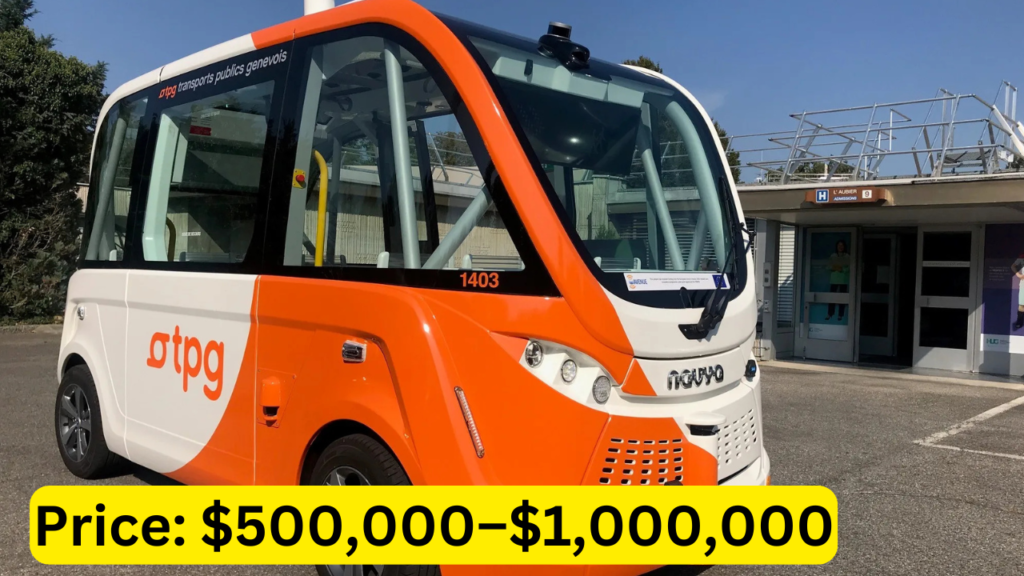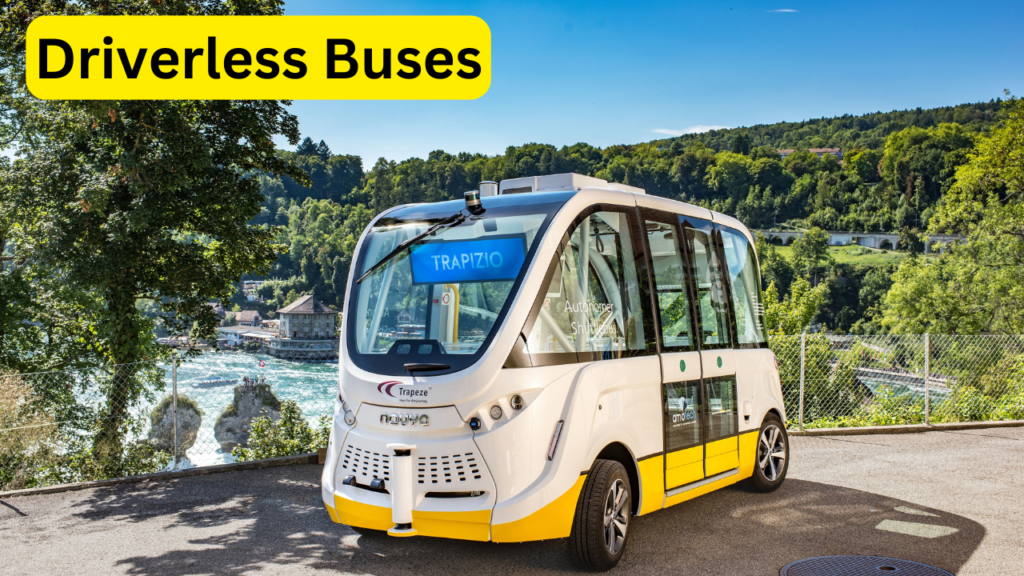Driverless Buses: The race to develop autonomous vehicle technology has taken an exciting turn, with companies shifting their focus from robotaxis to driverless buses. As cities face an impending shortage of qualified bus drivers and grapple with the inefficiencies of robotaxis, autonomous buses are emerging as a practical and sustainable solution. These vehicles, equipped with Level 3 autonomy, are already making waves in public transportation, offering a glimpse into the future of urban mobility.
Unlike robotaxis, which have been criticized for contributing to traffic congestion, driverless buses are designed to improve urban efficiency. Kevin DeGood, director of infrastructure policy at the Center for American Progress, highlights the stark difference between the two modes of transport. “Buses and rail reduce congestion, while robotaxis increase it,” he explains. This is primarily due to the phenomenon of “deadheading,” where ride-hailing vehicles return without passengers, a problem that buses largely avoid. With the ability to carry dozens of passengers during peak hours, autonomous buses are poised to revolutionize public transit systems.
Currently, self-driving bus trials are being conducted on private campuses like universities and medical centers, where traffic is minimal and speeds are low. These trials focus on Level 3 autonomy, which requires occasional human intervention. However, the next milestone is Level 4 autonomy, where buses can navigate public roads without human input. Leading this charge is San Jose–based Imagry, a company that develops autonomous driving software and retrofits standard electric buses with self-driving technology. Founded in 2015, Imagry initially specialized in computer vision but has since pivoted to become a key player in the autonomous bus market.
Also read: Ola Gen-3 Electric Scooters
Specifications of Driverless Buses
Below is a detailed table summarizing the key specifications of autonomous buses:
| Feature | Details |
|---|---|
| Autonomy Level | Level 3 (with plans for Level 4) |
| Passenger Capacity | 30–50 passengers (depending on model) |
| Power Source | Electric |
| Top Speed | 25–35 mph (40–56 km/h) |
| Navigation System | Advanced computer vision, LiDAR, and GPS |
| Operating Environment | Private campuses (current), public roads (future) |
| Manufacturer | Imagry (software and retrofitting) |
| Launch Date | Trials ongoing; full public rollout expected by 2025 |
| Price | $500,000–$1,000,000 (depending on customization and features) |
Features and Performance
Advanced Autonomy
Driverless buses are equipped with Level 3 autonomy, allowing them to operate with minimal human intervention. This technology relies on a combination of sensors, cameras, and artificial intelligence to navigate routes safely. The transition to Level 4 autonomy will enable these buses to handle complex urban environments without any human input.
Eco-Friendly Design
As electric vehicles, autonomous buses contribute to reducing carbon emissions and promoting sustainable urban transportation. Their quiet operation also minimizes noise pollution, making them ideal for densely populated areas.
Enhanced Safety
With advanced collision detection systems and real-time monitoring, driverless buses are designed to prioritize passenger safety. The integration of LiDAR and computer vision ensures accurate obstacle detection and route planning.
Design and Price
Sleek and Functional Design
Autonomous buses feature a modern, aerodynamic design optimized for efficiency and passenger comfort. The interiors are spacious, with seating arrangements that maximize capacity without compromising comfort.
Pricing Details
The cost of a driverless bus ranges from $500,000 to $1,000,000, depending on the level of customization and additional features. While the initial investment is high, the long-term savings in labor and operational costs make it a viable option for municipal transit agencies.

Launch Date and Unique Selling Points
Expected Launch
While trials are currently underway on private campuses, the full public rollout of Level 4 autonomous buses is expected by 2025. This timeline aligns with advancements in autonomous technology and regulatory approvals.
Unique Selling Points
- Congestion Reduction: Unlike robotaxis, driverless buses reduce traffic congestion by carrying more passengers and minimizing deadheading.
- Cost Efficiency: Over time, autonomous buses can lower operational costs by eliminating the need for human drivers.
- Sustainability: Electric-powered buses align with global efforts to combat climate change.
- Safety: Advanced sensors and AI ensure a safer travel experience for passengers.
- Scalability: These buses can be easily integrated into existing public transit systems.
Driverless Buses Conclusion
The advent of driverless buses marks a significant milestone in the evolution of public transportation. By addressing the challenges of driver shortages and traffic congestion, autonomous buses offer a sustainable and efficient solution for urban mobility. Companies like Imagry are at the forefront of this transformation, leveraging cutting-edge technology to make self-driving buses a reality.
As trials progress and Level 4 autonomy becomes achievable, the potential for driverless buses to reshape public transit systems grows exponentially. Their ability to carry dozens of passengers, reduce emissions, and operate safely in complex environments makes them a compelling alternative to traditional buses and robotaxis alike.
While the initial costs may be high, the long-term benefits of reduced operational expenses and improved urban efficiency justify the investment. Municipalities and transit agencies worldwide are likely to embrace this technology as it becomes more accessible and reliable.
In the coming years, driverless buses could become a common sight on city streets, offering a glimpse into a future where technology and sustainability go hand in hand. As we move closer to this reality, the focus will remain on ensuring safety, affordability, and seamless integration into existing infrastructure.
The journey toward fully autonomous public transportation is just beginning, but the potential for positive change is immense. Driverless buses are not just a technological innovation; they are a step toward smarter, greener, and more efficient cities.
Driverless Buses FAQs
1. What is Level 3 autonomy, and how does it work in driverless buses?
Level 3 autonomy, also known as conditional automation, allows a vehicle to handle most driving tasks independently but requires human intervention in complex or unpredictable situations. In driverless buses, this means the bus can navigate predefined routes, stop at designated points, and manage traffic interactions on its own. However, a human operator may need to take control in scenarios like severe weather, road construction, or unexpected obstacles. This level of autonomy is a stepping stone toward fully autonomous (Level 4) buses, which will operate without any human input.
2. How do driverless buses reduce traffic congestion compared to robotaxis?
Driverless buses are designed to carry multiple passengers at once, often transporting dozens of people during peak hours. This reduces the number of vehicles on the road, easing traffic congestion. In contrast, robotaxis typically carry only one or two passengers and contribute to congestion through “deadheading,” where the vehicle travels without passengers to pick up the next rider. By eliminating deadheading and maximizing passenger capacity, driverless buses offer a more efficient and sustainable solution for urban mobility.
3. Are driverless buses safe for public use?
Yes, driverless buses are equipped with advanced safety features, including LiDAR, radar, cameras, and artificial intelligence systems. These technologies enable the bus to detect and respond to obstacles, pedestrians, and other vehicles in real time. Additionally, autonomous buses undergo rigorous testing in controlled environments before being deployed on public roads. While no system is entirely risk-free, the combination of advanced sensors, redundant systems, and continuous monitoring makes driverless buses a safe and reliable option for public transportation.
4. When will driverless buses be available for public use?
Driverless buses are currently in the trial phase, operating on private campuses like universities and medical centers where traffic is light and speeds are low. These trials focus on Level 3 autonomy, with plans to transition to Level 4 autonomy in the near future. A full public rollout is expected by 2025, pending advancements in technology and regulatory approvals. Cities with progressive transportation policies and infrastructure are likely to be the first to adopt this technology.
5. How much does a driverless bus cost, and is it worth the investment?
The cost of a driverless bus ranges from $500,000 to $1,000,000, depending on the level of customization and additional features. While the initial investment is significant, the long-term benefits make it a worthwhile option for municipal transit agencies. Driverless buses eliminate the need for human drivers, reducing labor costs over time. They also operate more efficiently, lowering fuel and maintenance expenses. Additionally, their ability to reduce traffic congestion and emissions aligns with sustainability goals, making them a valuable investment for cities.
6. What makes Imagry a leader in autonomous bus technology?
Imagry, a San Jose–based company, has established itself as a leader in autonomous bus technology by developing cutting-edge software and retrofitting standard electric buses with self-driving capabilities. Founded in 2015, the company initially focused on computer vision for various applications before pivoting to autonomous vehicles. Imagry’s expertise in artificial intelligence, sensor integration, and real-time data processing enables it to create robust and reliable autonomous driving systems. By partnering with automakers and municipal transit agencies, Imagry is driving the adoption of driverless buses worldwide.
7. Can driverless buses operate in all weather conditions?
While driverless buses are designed to operate in a variety of weather conditions, extreme situations like heavy snow, dense fog, or torrential rain may pose challenges. Current autonomous systems rely on sensors like LiDAR and cameras, which can be affected by poor visibility or adverse weather. However, ongoing advancements in sensor technology and AI algorithms aim to improve performance in all environments. For now, driverless buses are most effective in moderate weather conditions and controlled environments, but future iterations are expected to handle more challenging scenarios.


